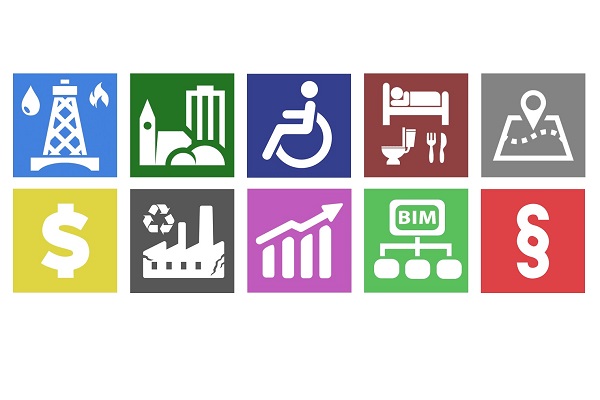Topics of lectures
1. The importance of buildings for energy supply in the technical infrastructure and in regional development.
2. Production of energy from non-renewable and renewable sources. Overview of regulations.
3. Power supply - concepts, power sources, types of electrical systems, objects.
4. Calculation of electricity demand, electricity distribution to consumers
5. Supply of energy gases - concepts, types of heating gases and their sources, gas reservoirs, gas distribution systems, objects.
6. Calculation of gas needs, distribution of gas to consumers
7. Heat supply - concepts, types of heat media and heat sources. Heat and Domestic Hot Water (TUV)
8. Calculation of heat demand, distribution of heat to consumers
9. Materials and methods for the storage of underground and overhead lines of electrification and gas pipelines
10. Materials and methods of depositing underground and above-ground hot water lines, objects
11. Protective and safety bands for power engineering.
12. The layout of the technical equipment.
13 Utilization of collectors. Anti-corrosion protection of underground power lines.
Themes of the Tutorials
1. Calculation of current electric power consumption of dwellings and civic amenities connected to a particular power line - commissioning of the program 1.
2. Calculation of the total annual and maximum hourly needs of natural gas for housing stock - commissioning of the program 2.
3. Calculation of the heat input of the building and the annual heat demand - commissioning of the program 3.
4. Principles of calculation of pressure losses in heat (hot-water) pipelines (Bernoulli equation ad.). 5. Principles of calculation of flow and pressure ratios of branch hot-water grids and calculation of heat transfer.
6. Principles of calculation of flow and pressure ratios in low and medium pressure pipelines.
7. Implementation of energy buildings.
8. Reconstruction of energy buildings, trenchless technology - pipe extrusion, pipe drawing into the existing pipe line.
9. Solution of situational drawings of the coordination of engineering networks in the urban and outlying towns and municipalities. Situations, transverse profiles, technical report
10. Processing area 4.
11. Excursion - Power Station
12. Time Reserve
Written work of the students is elaborated and submitted in practice, the programs are submitted on a continuous basis, no later than the beginning of the credit week. When using the computation program (in Excel), it is necessary to submit the used computer program (file)
1. The importance of buildings for energy supply in the technical infrastructure and in regional development.
2. Production of energy from non-renewable and renewable sources. Overview of regulations.
3. Power supply - concepts, power sources, types of electrical systems, objects.
4. Calculation of electricity demand, electricity distribution to consumers
5. Supply of energy gases - concepts, types of heating gases and their sources, gas reservoirs, gas distribution systems, objects.
6. Calculation of gas needs, distribution of gas to consumers
7. Heat supply - concepts, types of heat media and heat sources. Heat and Domestic Hot Water (TUV)
8. Calculation of heat demand, distribution of heat to consumers
9. Materials and methods for the storage of underground and overhead lines of electrification and gas pipelines
10. Materials and methods of depositing underground and above-ground hot water lines, objects
11. Protective and safety bands for power engineering.
12. The layout of the technical equipment.
13 Utilization of collectors. Anti-corrosion protection of underground power lines.
Themes of the Tutorials
1. Calculation of current electric power consumption of dwellings and civic amenities connected to a particular power line - commissioning of the program 1.
2. Calculation of the total annual and maximum hourly needs of natural gas for housing stock - commissioning of the program 2.
3. Calculation of the heat input of the building and the annual heat demand - commissioning of the program 3.
4. Principles of calculation of pressure losses in heat (hot-water) pipelines (Bernoulli equation ad.). 5. Principles of calculation of flow and pressure ratios of branch hot-water grids and calculation of heat transfer.
6. Principles of calculation of flow and pressure ratios in low and medium pressure pipelines.
7. Implementation of energy buildings.
8. Reconstruction of energy buildings, trenchless technology - pipe extrusion, pipe drawing into the existing pipe line.
9. Solution of situational drawings of the coordination of engineering networks in the urban and outlying towns and municipalities. Situations, transverse profiles, technical report
10. Processing area 4.
11. Excursion - Power Station
12. Time Reserve
Written work of the students is elaborated and submitted in practice, the programs are submitted on a continuous basis, no later than the beginning of the credit week. When using the computation program (in Excel), it is necessary to submit the used computer program (file)
